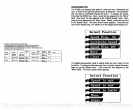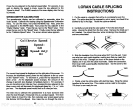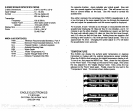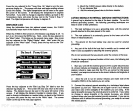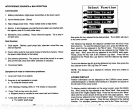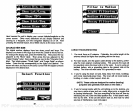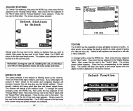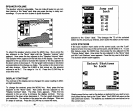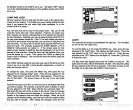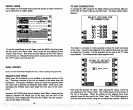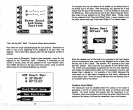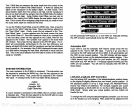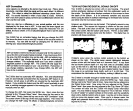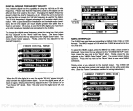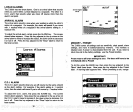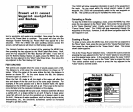
the
position
screen to see if ASF's are in use. The letters "ASF"
appear
next to the
latitude/longitude display
on the
position
screen when ASPs
are in use.
JUMP AND LOCK
All loran receivers have to lock onto the third
cycle
of the
signal
trans-
miffed from the stations. The Z-9500
may
have trouble
finding
the third
cycle
if
you operate
the unit under
high
noise
conditions,
or at the
extreme limit of its
range.
You can force the unit to
jump
to the
proper cycle.
You can do this
using
the
'Yump
and Lock" menu selection.
However,
we caution
you
that it
requires
an intimate
understanding
of loran
signals
and shouldn't
be used
carelessly. Basically, you
have to know
precisely
what the TD's
for
your
exact location should be. If the ID for each station
you
wish to
use is off
by
ten or more
micro-seconds, you
can move it
using
the
jump
and lock menu. You move
the
TD
by
ten micro-seconds
each time
you
jump
one
cycle.
For
example, suppose
the Z-9500
displays
a TD of
45349.33
micro-seconds for station
X. If
the
correct value for that
station at
your
location is
45359.33,
then the
displayed
TD is ten micro-
seconds or one
cycle
low.
Using
the
Jump
and Lock stations
menu,
you
jump
the station
by
+1
cycle.
This causes the Z-9500 to
display
the
correct value of 45359.33. The unit will now track the station
using
this
cycle
correction.
The Z-9500
will
stop using
the
cycle
data
you
used in the
jump
and lock
menu if
you
do a new GRI or initial
position
initialization,
a
preset,
or
when
you
turn the unit off.
To
change
the
cycle,
first
press
the MENU
key,
then
press
the
key
adjacent
to the
"Change Setup"
label. Press the
key adjacent
to the
"More" label until the
"Jump
& Lock Sta." label
appears.
Press the
key
next to that label. The screen shown at the
top
of the next
page
appears.
Press the
key
next to the "Set." to move the box to the station letter that
you
wish to
change.
For
example,
to
jump
the
cycle
on station
Z,
press
the
key adjacent
to the "Sel." label until the box surrounds letter
"Z".
Now
press
the
key
next to the
up
arrow in the
"Jump"
menu to increase
the
cycle,
or the down arrow to decrease it. As
you press
the
key,
the
number
in
the station's label will reflect the
change.
When the
cycle
change
is at the desired
setting,
move the box to the next station's letter
that
you
wish to
change.
After
making
the
changes, press
the
key
LIGHT
The
keyboard
and
display arebacklighted
for
night
use. Turn the
lights
on and off from the
Light
menu.
To turn the
lights
on or
off,
press
the MENU
key.
Next,
press
the
key
adjacent
to the
"Light"
label. This
displays
the
light
menus. Press the
key adjacent
to the "ON" label to turn the
lights
on. Press the
key
adjacent
to the "OFF" label to turn the
lights
off. Press the CLEAR
key
to
erase the menu.
The
light
menu also
appears
each time the Z-9500 is turned on. The
lights
and the menu will turn themselves off after a few seconds unless
the
key adjacent
to the ON
key
is
pressed.
This makes it easier to turn
the
lights
on at
night
when the Z-9500 is first turned on.
98
39
Disp.
Clear
Lifl-t
vssa&W°
I I
16
____
32
____
-18
64
80
KHZ
jC
1ear
PDF compression, OCR, web-optimization with CVISION's PdfCompressor



